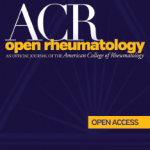
Dr. Daikh
Authors may submit articles directly to ACR Open Rheumatology, but in addition, authors whose articles were submitted to A&R or AC&R and just missed the threshold for acceptance but were still viewed by the editor as being of scientific value will be invited to have their articles internally resubmitted to the new journal. In most cases, the reviews from A&R or AC&R will be used, expediting the time between submission and decision.
ACR Open Rheumatology will be published by John Wiley & Sons. After the first 25 articles are published, the journal will be submitted for indexing by PubMed, says Ms. Diamond. The website for the new journal is www.acropenrheum.org.
Q&A with the Co-Editors-in-Chief
Drs. Katz and Yelin share their thoughts on the benefits of ACR Open Rheumatology to the ACR, researchers and readers with The Rheumatologist:
TR: What was the idea behind the creation of ACR Open Rheumatology? Why is it beneficial for the ACR to have an open access journal along with its traditional-
format journals?

Dr. Yelin
Dr. Yelin: “ACR Open Rheumatology solves several problems in the peer-reviewed literature. The most important one isn’t directly related to the ‘open access’ vs. subscription model. Instead, it deals with the fact that the ACR’s two existing journals do not have the space to publish all the meritorious submissions they receive. The ACR can now provide more space for publishing. With open access, in fact, there is no limit to the number of meritorious manuscripts that can be published. With acceptance rates at A&R and AC&R so low, we estimate that there is at least another quintile of submissions that tough peer review would suggest deserve to see the light of day. ACR Open Rheumatology will provide the opportunity of publication to the authors of these submissions and, to the ACR, the opportunity to keep the submissions within its publishing house.”

Dr. Katz
Dr. Katz: “There is a trend among some funding entities, particularly in Europe, to require publication in open access journals—not just open access articles within traditional journals, but publication in completely open access journals. We hope that ACROR will be an attractive option to authors with these requirements.”
TR: What will make the journal unique and more open to potential authors, including rheumatologists and experts from other subspecialties?
Dr. Yelin: “ACR Open Rheumatology is designed to be more open in more than just how the publication is financed. There has always been some overlap between the topics and methodologies covered by A&R and AC&R. However, the new journal is, by design, intended to cover all areas within rheumatology and about the diseases subsumed by this subspecialty. This enables us to make sure the differing perspectives of authors—and readers—across areas of inquiry will be reflected in each issue. We are also intending to be open to explicitly cross-disciplinary work. A lot of very important work crosses fields of inquiry, for example, epigenetics and big data science.
“Finally, because we previously served in the same role in AC&R, we will try to replicate one of the successful initiatives of our tenure at that journal by explicitly stoking fields of inquiry by soliciting manuscripts for themed issues in important new areas. As research delves into the common basic mechanisms underlying many diseases related to inflammation, there will no doubt be opportunities to explore the implication for such issues, for example, as the appropriate care model for systemic lupus erythematosus, which may affect multiple organ systems traditionally within the purview of diverse specialties.”
TR: What type of articles do you hope to publish?
Dr. Yelin: “There are no limits to the kinds of inquiry we hope to publish nor to the methodologies used in the research. However, given that we will explicitly cover the entire range of areas subsumed by both A&R and AC&R, we will be especially open to manuscripts that push the boundaries among disciplines within rheumatology research and to topic areas that do the same. The bottom line is the same as the existing journals: innovation, rigor and relevance.”
Dr. Katz: “One specific advantage that ACR Open Rheumatology will have is that limits on article length and number of tables can be less stringent. This may be particularly attractive to investigators who would like to display additional tables or figures, or who have very complex methods that need more extensive descriptions. Because of the broad range of topics, from basic science through health services research, we would especially like to encourage submissions from multidisciplinary research groups—topics that perhaps don’t fit cleanly into the purview of either A&R or AC&R, but are relevant to rheumatology.”
TR: How do you envision working together, along with your team of deputy editors?
Dr. Yelin: “No two editors cover the areas of inquiry relevant to ACR’s membership. We ourselves know best the methods of epidemiology, health services research, behavioral science and public policy. Our deputy editors, Drs. Daikh and Cronstein, cover basic and translational sciences and clinical care. They will be responsible for handling manuscripts in those areas. We will work together to ensure submissions that cross disciplines are welcome and handled with the same rigor of peer review that those within our areas of expertise receive. One nice feature of open access journals is that once we—or they—make decisions about the merit of manuscripts, there is no limit to the number that can be published.”


